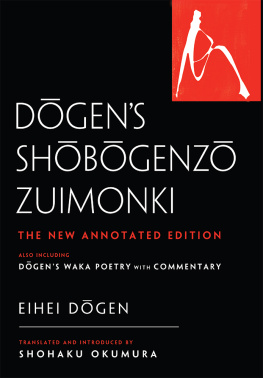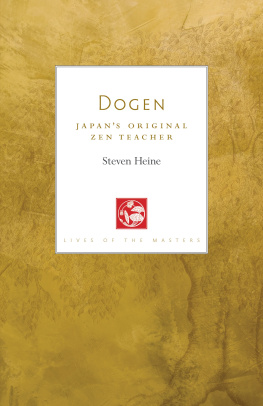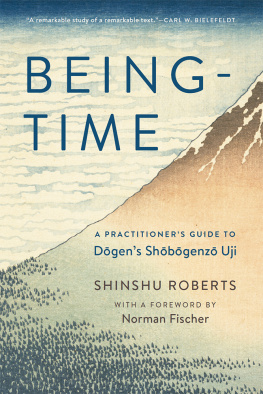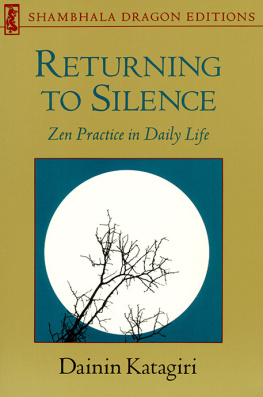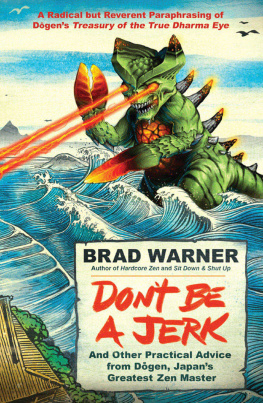ABOUT THE BOOK
Spiritual practice is not some kind of striving to produce enlightenment, but an expression of the enlightenment already inherent in all things: Such is the Zen teaching of Dogen Zenji (12001253) whose profound writings have been studied and revered for more than seven hundred years, influencing practitioners far beyond his native Japan and the Soto school he is credited with founding. In focusing on Dogens most practical words of instruction and encouragement for Zen students, this new collection highlights the timelessness of his teaching and shows it to be as applicable to anyone today as it was in the great teachers own time. Selections include Dogens famous meditation instructions; his advice on the practice of zazen, or sitting meditation; guidelines for community life; and some of his most inspirational talks. Also included are a bibliography and an extensive glossary.
DOGEN (12001253) is known as the founder of the Japanese Soto Zen sect.
Sign up to learn more about our books and receive special offers from Shambhala Publications.

Or visit us online to sign up at shambhala.com/eshambhala.
Translators
Reb Anderson
Edward Brown
Norman Fischer
Blanche Hartman
Taigen Dan Leighton
Alan Senauke
Kazuaki Tanahashi
Katherine Thanas
Mel Weitsman
Dan Welch
Michael Wenger
Contributing Translator
Philip Whalen
BEYOND THINKING
A Guide to Zen Meditation
Zen Master Dogen
Edited by Kazuaki Tanahashi
Introduction by Norman Fischer

SHAMBHALA
Boston & London
2012
SHAMBHALA PUBLICATIONS, INC.
Horticultural Hall
300 Massachusetts Avenue
Boston, Massachusetts 02115
www.shambhala.com
2004 San Francisco Zen Center
Cover art by Kazuaki Tanahashi
Text from Moon in a Dewdrop: Writings of Zen Master Dogen, edited by Kazuaki Tanahashi, 1985 by San Francisco Zen Center, reprinted by permission of North Point Press, a division of Farrar, Straus and Giroux: Rules for Zazen, On the Endeavor of the Way, Regulations for the Auxiliary Cloud Hall, and a poem, The Point of Zazen, After Zen Master Hongzhi. Text from Enlightenment Unfolds: The Essential Teachings of Zen Master Dogen, edited by Kazuaki Tanahashi, 1999 by San Francisco Zen Center, reprinted by permission of Shambhala Publications: Recommending Zazen to All People.
All rights reserved. No part of this book may be reproduced in any form or by any means, electronic or mechanical, including photocopying, recording, or by any information storage and retrieval system, without permission in writing from the publisher.
LIBRARY OF CONGRESS CATALOGING-IN-PUBLICATION DATA
Dogen, 12001253.
Beyond thinking: a guide to Zen meditation/Zen Master Dogen ;
edited by Kazuaki Tanahashi.1st ed.
p. cm.
Includes bibliographical references.
eISBN 978-0-8348-2342-6
ISBN 978-1-59030-024-4 (pbk.: alk. paper)
1. MeditationStsh. 2. StshDoctrines. I. Tanahashi, Kazuaki, 1933 II. Title.
BQ9449 .D652 2004
294.34435dc22
2003024954
To Zenshin Ryufu Philip Whalen
19232003
whose life paralleled the history of Zen in America from his involvement in the 1950s in Buddhism and Beat poetry, to his studies in Japan in the 1960s, to his ordination as a Zen priest in 1972, to his subsequent teaching for thirty years.
His work with us in translating Dogen was just one of many contributions to bringing Zen to America.
Contents
E IHEI D OGEN (12001253) wrote practical instructions on meditation for beginners and adepts, which are still enormously useful in our time. Much of his extensive writing comes from and refers to advanced experiences of zazen or meditation in sitting posture. Although monk Dogen simply called his teaching the buddha way, he has been regarded as founder of the Soto School, one of the two major schools of Zen Buddhism in Japan.
For this book we have selected his essays, talks, and instructions that touch on various aspects of Zen meditation. We present the text in four parts: Entering Zazen, Zazen Experience, Zazen in Community, and Zazen through the Seasons.
One of the foremost thinkers and writers in Japanese history, Dogen elucidates his teaching in an imaginative and paradoxical way. Some of his linguistic somersaults reflect his freedom from dualistic thinking and conventional logic. It could take one many years to make sense of some of his lines. Thus, Beyond Thinking is for advanced practitioners of meditation as well as for beginners.
It is stunning to see how much of his basic and practical instructions has been followed in Japan until now and how much of it is being adopted by Zen centers in the Western world. In the Introduction, Norman Fischer discusses the value of Dogens teaching to those who practice Zen today, as well as some points that do not seem to be relevant any longer.
Beyond Thinking is the third Dogen book project of San Francisco Zen Center, following Moon in a Dewdrop and Enlightenment Unfolds. For details of Dogens life, philosophy, and writings, please refer to the previous books.
We have tried to make our translations faithful to the original expressions and accessible to anyone who practices meditation or wants to do so. So, in some cases we have translated the Japanese words kekka fuaza as sitting in cross-legged position, which is close to the original. But in other cases we have translated it as sitting in meditation posture because this is more inclusive of those who are unable to sit in traditional ways. We have translated hishiryo as beyond thinking and nonthinking because both English terms have advantages and limitations. The interchangeable use of the two terms can give a fuller transmission of meanings from one language to another. We have indicated examples of using two translated terms for one original term in our glossaries. I hope some of the glossary definitions will be helpful in decoding the apparently enigmatic expressions for which Dogen is renowned.
I feel extremely privileged to have had the opportunity to work with my cotranslators, who are all Zen teachers and fine writers. Each of the innumerable sessions of translating a text with one of my partners has been, without exception, a tremendously joyous learning experience. I am particularly grateful to Norman Fischer, who has written the excellent Introduction; to Taigen Daniel Leighton, who did scholarly editing and updating of the Selected Bibliography with his extensive knowledge; and to Dan Welch, who put an amazing amount of energy into editing the entire text, examining every word meticulously, and challenging the rest of the translators with alternative suggestions.
My gratitude goes to those who have participated in the Dogen seminars I facilitated in the past three years. Their valuable suggestions helped us to improve our draft translation. I would like to thank the roshis and senseis, who are the spiritual leaders of the Zen centers that hosted the seminars: Richard Baker (Dharma Sangha Europe and Crestone Mountain Zen Center); Chozen and Hogen Bays (Great Vow Zen Monastery); Kyogen and Gyokuko Carlson (Dharma Rain Zen Center); Joan Halifax (Upaya Zen Center); Blanche Hartman, Linda Ruth Cutts, and Paul Haller (San Francisco Zen Center, Green Gulch Farm, and Tassajara Zen Mountain Center); Enkyo OHara (Village Zendo); Katherine Thanas (Santa Cruz Zen Center and Monterey Bay Zen Center); and Jisho Warner (Stone Creek Zendo).
Next page


